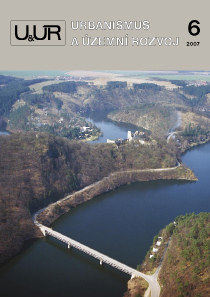
Application of Possible Indicators of Sustainable Development in Physical Planning, by Karel Maier, Vít Řezáč, Jakub Vorel, Alena Dodoková
The new Building Act identifies sustainable development as a basic objective of urban planning in the Czech Republic. The concept of sustainable development is thus undisputably accepted; but its implementation in everyday practice of planning and decision-making still needs to be clearly specified.
On the background of the new legislation and using the instruments and procedures of the Act, the article outlines a set of possible indicators to be applied in the assessment and monitoring of plans on regional and local levels. These indicators are grouped as: (1) sustainable use of natural resources and energy; (2) balanced environmental systems; (3) sustainable structure and growth of the economy; (4) social and territorial cohesion; (5) mitigation of the impacts of natural disasters and infrastructure failures. The indicators may be complemented by sets of issues to be discussed in the ex-ante assessment and ex-post evaluation.
Also, examples of normative indicators are given to resolve the current problems of sustainable development in physical planning. The identification of the key issues of sustainable development is to be taken into account in the regular updates of the National Development Policy and in the regional Principles of Spatial Development, to be completed by
the end of 2008.
Spatial Aspects of the Current Development of Brno’s Retail Shopping Network, by Ondřej Mulíček
The contribution is focused on the development of the retail shopping network in the city of Brno after 1989, with special attention to the spatial aspects of the changes occurring after 1997. The territory of the city was divided into several functional and socio-economic types, so that the spatial distribution and the dynamics of retail shopping could be more comprehensively described. The indicators of the development of the total retail shopping area (and of the assortment segments too) enabled us to identify the varied dynamics of particular zones within the administrative territory of the city.
Cross-Border Planning: The Reflections of a Planner, by Jaroslav Bedrna
I had the opportunity to participate in the first spatial planning coordinations over the Czech border right after 1989, and in multinational ones for the territory of central and south-east Europe soon after. Since such collaboration inevitably brings interference among various planning systems and strategies, requiring substandard kinds of approach, I would like to give the readers a few observations and some of the experience I could gather. Yet, instead of detailed narration it is rather going to be remembrances, remarks, and brief comments.
Quo vadis, Physical Planning? by Martin Jirovský
The article contains remarks and recommendations about physical planning given from two very different viewpoints — one of a planner who only recently ceased being active and the other of a representative of the administration. The author outlines some essential problems which in his opinion were not relevantly solved under the previous legislation and, especially, under the former practice of state administration. Nevertheless, many of those issues remain topical even now, after the enactment of the new Building Act.